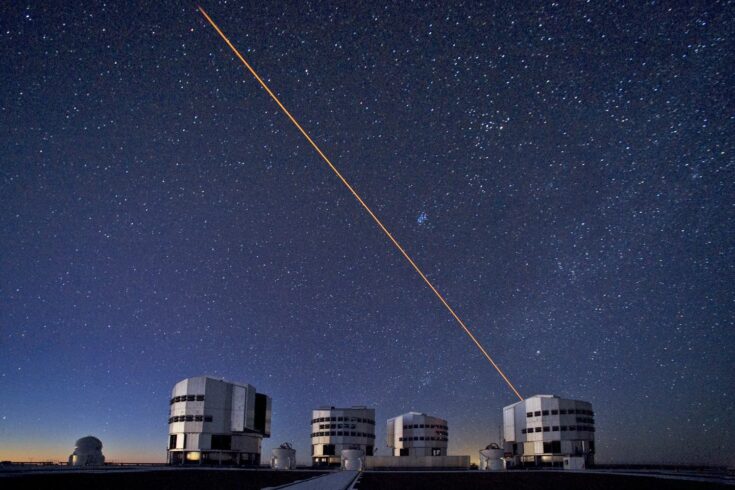ESO’s VLT, located on the Cerro Paranal Mountain in the Atacama Desert of northern Chile, is one of the most advanced optical telescopes ever built.
Since recording its first light on 25 May 1998, it has produced an array of ground-breaking scientific discoveries including the first image taken of a planet beyond the Solar System.
Historic legacy
ESO’s VLT consists of four state-of-the-art ‘Unit Telescopes’ which combine to produce images of stars with almost unparalleled resolution.
This advanced capability has enabled astronomers to produce over 10,000 scientific papers based on data collected by VLT telescopes (an average of more than one peer-reviewed paper per day since operations began).
Transformative research conducted with the help of the VLT include:
- studies of the supermassive black hole at the centre of the Milky Way
- work which established the accelerated expansion of the Universe
Both of these studies resulted in Nobel Prizes.
Other key findings include the first direct image of a planet outside our Solar System and the characterisation of the first visible counterpart to a gravitational wave source.
Understanding our Universe
Professor Mark Thomson, STFC Executive Chair, said:
The VLT has been at the forefront of ground-based optical astronomy for many years, providing a powerful window on the cosmos.
It has enabled a generation of UK scientists to conduct the world-leading research that has fundamentally changed our understanding of the Universe.
This landmark anniversary is a proud moment for astronomy and science the world over and an opportunity to reflect on how far we have come in the past 25 years, but also how much more there is to discover in the coming years.
Longstanding UK support
The UK, via STFC, is the second largest funding contributor of ESO, the organisation which developed and operates the VLT, and provides a range of expertise and services to support its scientific operations.
Notable UK contributions to ESO and the VLT include:
- the K-band Multi-Object Spectrograph instrument, designed and constructed by the STFC UK Astronomy Technology Centre (UK ATC) in Edinburgh, which enables VLT users to quickly uncover fine details of distant galaxies
- the Visible and Infrared Survey Telescope for Astronomy telescope, the vision of a consortium of 18 UK universities led by Queen Mary University and project managed and constructed by UK ATC, which is used to map the sky
These and other contributions have led to several game changing UK-led astronomical discoveries.
In 2019, a team led by the University of Warwick discovered the first giant planet orbiting a white dwarf star, providing a glimpse into the likely future of our Solar System.
In 2021, a team led by Stefano Bagnulo at the Armagh Observatory and Planetarium in Northern Ireland used the VLT to characterise what could be the first truly pristine comet ever observed.
A bright future
The VLT is still very much at the forefront of science and engineering and is expected to continue making key discoveries for years to come.
One ongoing improvement is the development of the Multi-Object Optical and Near-infrared Spectrograph or MOONS instrument which is due to be installed at the VLT in early 2024.
MOONS, which is being constructed at UK ATC, is a next generation spectrograph that will simultaneously provide optical to near-infrared spectra for 1000 objects.
Its unique capabilities will be used to survey millions of stars and galaxies throughout most of the history of the Universe.
Connecting great minds
Professor Gillian Wright, Director at the STFC UK ATC, said:
It has been a privilege for UK ATC to contribute to the VLT and the remarkable achievements that it has made possible.
The VLT is a shining example of what can be achieved when the best minds from across the world are brought together to forward a common mission of science and exploration.
This anniversary is an opportunity to acknowledge and celebrate the diverse contributions of the hundreds of scientists, engineers, and technicians from Edinburgh to Chile and beyond who have made the VLT and its discoveries possible.
Top VLT discoveries
ESO will be celebrating the VLT in its new Chasing Starlight YouTube show, which will highlight some of the VLT’s top discoveries in its first episode.

